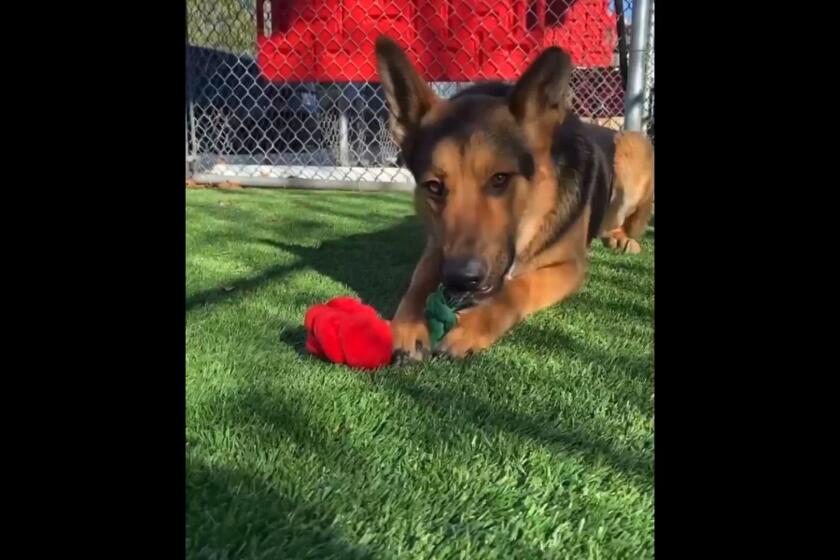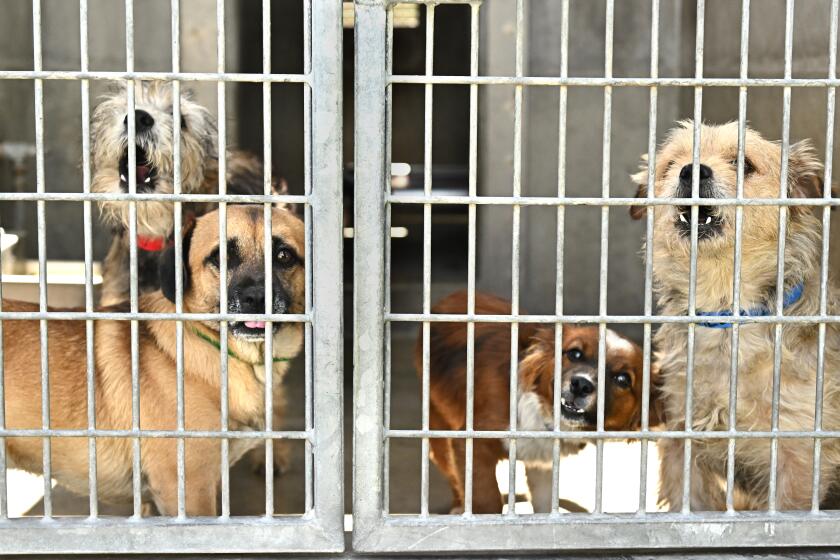California wants better animal shelter conditions, stray population curbed

- Share via
Cats and dogs can’t speak up for themselves, but their allies have been making a lot of noise in the California Legislature recently.
The overcrowded and unsafe conditions of animal shelters are the topic of several Senate and Assembly bills aiming to improve conditions in California’s animal facilities and curb the stray cat and dog population.
The proposed bills making their way through committees includes legislation to promote the certification of more veterinary students, standardize the data-reporting process in shelters, update the state’s dog-breeding rules and make it easier to adopt puppies and kittens, among others.
Overcrowded animal shelters is not a new problem for larger counties across the state, but following the end of the COVID-19 lockdown, some people who adopted animals suddenly started to surrender their dogs and cats into the already taxed shelter system.
County and city agencies have pointed to a severe lack of qualified staff to perform medical procedures as one of the reasons that animal shelters have experienced overcrowding in recent years.
Matt Haney introduced Assembly Bill 2216 earlier this month, which he said requires landlords to ‘have a reasonable reason(s) for not allowing a pet.’
Among the proposed legislation is a bill to establish a high-volume spay and neuter certification program for veterinary students at UC Davis and the Western University College of Veterinary Medicine in Pomona.
Senate Bill 1233 author Sen. Scott Wilk (R-Santa Clarita) wants to expand the number of professionals who can perform spay and neuter services and drive down costs for the procedures, which can cost up to $550, according to the senator’s office.
“Overcrowding at California’s animal shelters, especially in the High Desert, has been at crisis levels for too long. Animals are being put down through no fault of their own, and we have a responsibility to do something about it,” Wilk said in a statement.
The county’s Palmdale Animal Care Center was supposed to be a cutting-edge shelter that would relieve overcrowding and reduce euthanasia. But that’s not how it’s turned out.
If the measure is approved, the state Legislature will request the governing body of the University of California to establish the programs.
The bill took another step to becoming law on Monday, when it passed out of the Senate Committee on Business, Professions and Economic Development.
Similarly, Sen. Janet Nguyen (R-Huntington Beach), introduced a pair of bills dubbed by her office as “PAWSitive Change 4 Pets” that seek to establish a standardized format for reporting data from the state’s 232 animal shelters and clarify the practice of capturing stray cats, fixing them and releasing them back into the wild.
Proposed legislation seeks to reintroduce wolverines to California, which lacks a permanent population of the protected animals.
SB 1459 would offer a two-pronged approach to standardizing reporting practices in animal shelters and a uniform solution to controlling the cat population. In counties with more than 400,000 residents, shelters would be required to provide regular updates on animal intake, outcomes for those animals and the percentage of kennel spaces that are available, along with the number of animals scheduled for euthanasia.
“Animals have no voice. So we are their voice,” Nguyen said in a statement.
The bill is designed to improve shelter management. It would also clear up some ambiguity in the state’s penal code on animal cruelty that makes it a misdemeanor to abandon an animal. State law does not recognize that some animal rescue organizations would rather fix stray cats and release them back in the wild rather than place such animals into shelters or put them up for adoption.
Nguyen says this has hampered efforts for “trap-neuter-return” programs carried out by shelters to get stray cat populations in check. Her office based part of the the bill on the findings of a 2022-23 grand jury report that found the Orange County Animal Services eliminated its own TNR program because officials believed the program was violating state law.
The second bill from Nguyen’s office, SB 1478, would require a veterinary assessment of animals when they enter the shelter system and establish rules to address medical conditions for shelter animals, such as the spread of infectious diseases in kennels.
The efforts to clear overcrowded shelters and curb stray animal populations is a statewide issue, but it’s most pronounced in Los Angeles.
Nonprofit rescue groups that regularly interact with Los Angeles Animal Services say the city’s shelters are poorly managed and in crisis. The groups argue that dogs and cats in the shelters are living in poor conditions despite the city’s best efforts to work with rescue and adoption groups.
For many volunteers in L.A.’s animal shelters, there is a sense that the city’s shelter system will break down unless something changes.
City officials say they recognize that overcrowding is an ongoing problem, but the blame should not be laid on shelter management.
Councilmember Eunisses Hernandez — chair of the Neighborhoods and Community Enrichment Committee, which oversees the city’s Animal Services — said the problem goes back decades.
“This department has been so chronically understaffed and underfunded for years,” Hernandez told The Times in March when animal rights activists called for a change in management with the city’s shelter system.
There is not enough space across the city’s six animal shelters to accommodate the need. Data from the city controller’s office shows that more dogs and cats are coming into the shelters than are being adopted.
L.A. will stop issuing new dog breeding licenses in an effort to halt the overcrowding crisis at the city’s animal shelters.
The latest data shows there are nearly 500 dogs in the South Los Angeles animal shelter but only enough kennels and cages for 243.
Several other bills are currently making their way through committees that seek to address animal-related oversight, including Assembly Bill 2425 from Assemblymember Bill Essayli (R-Riverside) that would update the state’s laws on dog breeding and AB 1988 from Assemblymember Al Muratsuchi (D-Rolling Hills Estates) that would ease adoption rules for puppies and kittens rescued by adoption organizations.
Times reporting fellow Caroline Petrow-Cohen contributed to this report.
More to Read
Sign up for Essential California
The most important California stories and recommendations in your inbox every morning.
You may occasionally receive promotional content from the Los Angeles Times.



















